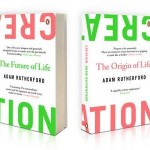
Creation: The Origin of Life / The Future of Life will get its paperback release on the 6th February 2014, giving anyone that missed the hardback release last spring a chance to catch up on the time spanning ping pong show of the double edged book. Expect a short, sharp whistle stop tour from the self professed author, broadcaster, scientist and geek, but with an approachable method of explaining the complexities of life.
In the opening section of the book, The Origin of Life, Rutherford spills out a joy ride of life’s evolution with a story that spans some four billion years. Using the most up-to-date scientific knowledge, the opening half of the book sets out to explain what life is and how it started in the first place. It lays down the big questions like a gauntlet for modern science and uses it to plot out the reality of it as we understand it scientifically today. It’s a story that goes well with Donald E. Canfield’s Oxygen: A Four Billion Year History, which was released on hardback at the end of last year.
This leads into a focus on the next foray into the conundrum of life for science in general as Rutherford discusses in thrilling tones the work of scientists in creating new life in the confines of the lab. The advances, known as synthetic biology, are underway in laboratories throughout the world and while it’s easy to make the jump to Frankenstien’s Monster, the book looks at the science of how it works and some insights into the benefits of the research to humankind. For anyone that saw the episode of Dara O’Briain’s Science Club that featured the work to synthetically create a beating heart, you’ll probably know what some of these might be in advance.
Creation is far from a detailed text book at just 272 pages, but it is an exciting fly through of the latest scientific understanding of the origins of life as well as a useful introduction to synthetic biology. For advanced biologists out there it’ll make an entertaining and short reiteration of what you’ll undoubtedly be familiar with, but for anyone else interested in the biological sciences it’s a great insight into the latest scientific stand-point on life and how it’s shaping laboratory research and breakthroughs.
If you’re not familiar with Adam Rutherford, he’s the editor of Nature Magazine in addition to writing for The Guardian newspaper. He’s also the presenter of the BBC Radio 4 show Inside Science and just to add even more weight to his credentials, his documentaries The Cell, The Gene Code and Horizon: ‘Playing God’ have gone on to win a number of awards. Creation: The Origin of Life / The Future of Life is his first book and hopefully it will spawn more than a few more with just as many huge chunks of scientific insight.


